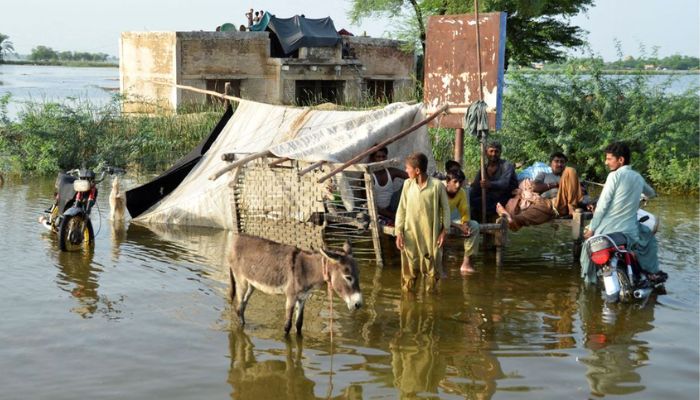How can Pakistan reduce impacts of climate change on the poorest
Pakistan needs to improve its capacity for rapid damage assessment following extreme weather events
September 19, 2022

It will come as no surprise to much of Pakistan’s population that their country ranks among the lowest for disaster risk management for water security in Asia, according to the Asian Water Development Outlook (AWDO).
Following the extreme heatwave of May — the city of Jacobabad hit 51 degrees C on May 14 — Pakistanis are now experiencing the most extreme flooding of their lifetime. These were two systemic, interlinked extreme events, with the hotter air earlier in the year holding more moisture and melting glaciers foreshadowing the floods.
Government agencies were ill-prepared, and, as always, the poor are suffering the most; the provinces of Balochistan and Sindh were hit the hardest, and poorer and rural populations lost not only their homes but also their income and livelihoods. If in May crops and livestock were burning in the heat, by August they were flooded. The livelihoods of over 33 million people have been devastated by the floods and more than 1,400 people have died.
Both climate extremes have worsened the already high levels of water and food insecurity: Seventy-two million people in the country are either moderately or severely food insecure and four out of five Pakistanis cannot afford a healthy diet. Water and food insecurity are exacerbated by a lack of reliable clean energy access: less than two-thirds of the rural population is connected to the national electricity grid, and outages of 18 hours a day are the norm.
And while Pakistan’s Vision 2025 explicitly calls for the design of water, food and energy security policies that address climate change while protecting natural resources, frameworks and policies for implementation on the ground remain lacking.
To address this and future extreme events linked to climate change, systemic water-energy-food-environment plans and programmes are urgently needed. These include:
Providing immediate relief to the most vulnerable: relief efforts should focus on reopening schools, or in the interim, establishing transition schools and health facilities in tentage areas, and on providing food relief through schools and social assistance through women’s self-help groups.
Also, farmers need timely access to seeds, fertilizers and other inputs through concessional loans from the government to restart food production as soon as floodwater recedes. The country will need food aid to address the issue of growing undernutrition and other aid to tackle health problems associated with a lack of drinking water.
Reducing the long-term adverse effects of the crisis through sustained relief: a CGIAR study of the uneven relief effort following the 2010 Pakistan floods shows that communities that received Citizens Damage Compensation (Watan Card) Program flood relief — which provided cash equivalent to 9.4% of annual household expenditures in each of the three years following the disaster — were able to restore their livelihoods, replace damaged assets, and coped better in managing mental stress as a result of the disaster.
Implementing integrated forecasting systems and associated disaster action: this step brings together the Federal Flood Commission; the National Disaster Management Authority (NDMA) and the Provincial Disaster Management Authority (PDMA), the authorities responsible for food, water and energy, and the National Disaster Risk Management Fund. The focus should be on reducing impacts on the poorest populations.
Pakistan also needs to improve its capacity for rapid damage assessment following extreme weather events using the latest developments in satellite imagery, drones and machine learning.
Reviewing rural infrastructure for better heat stress, drought and flood management: flood drainage investment along the left and right bank of River Indus in Sindh and a review of all rural infrastructure are urgently needed; climate proofing needs to jointly consider water, food and energy security and environmental sustainability.
Better understanding and developing the country’s many water storage options: Pakistan needs to start considering complementary storage including aquifer systems, soils and trees, wetlands, and grey infrastructure that can support water, energy and food security and environmental sustainability. Storage diagnostic is currently being undertaken by the CGIAR NEXUS Gains Initiative.
In the medium term, reviewing and revising national food production strategies to improve the country’s climate resilience: with both droughts and floods on the rise in Pakistan, the use of scarce water resources (despite the flooding) for the production of extremely water-intensive crops like cotton, rice and sugarcane for export should be reassessed.
While these three crops are important foreign exchange earners, the growing shares of these areas should instead be dedicated to vegetables, fruit trees, and other high-value but water-thrifty and leguminous crops that are essential to improve national diets, reduce over-exploitation of water resources and improve rural livelihoods.
Systemic cross-sectoral thinking across the water, energy, food and environmental systems is central to the climate-resilient development of Pakistan as the complex interlinkages, if not considered, are bound to worsen impacts on the poor.
This is not the last summer of climate extremes in Pakistan, but there are clear opportunities to reduce the adverse impacts of climate change on the poorest rural population of Pakistan. These should be seized now.
Dr Mohsin Hafeez works at the International Water Management Institute (IWMI).
Wajid Rana and Claudia Ringler work at the International Food Policy Research Institute (IFPRI).
Originally published in The News













